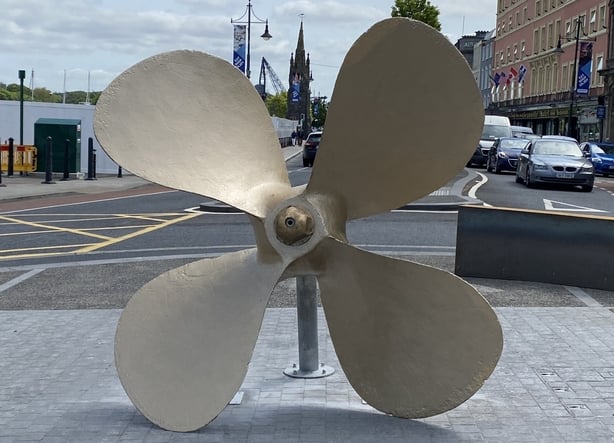The propeller of the country's last working steam dredger has been given a new home in the centre of Waterford city.
The SS Port Láirge worked on the river Suir for over 70 years until the 1980s and can now be seen at Bannow Bay on the Wexford coastline, but its propeller is now on display on Waterford's quays.
Affectionately-known as "the mud boat," the SS Port Láirge was used for dredging to ensure that the river was open and accessible to shipping and was considered an important part of the work of the port for decades.
Refurbishing and relocating the propeller of the Port Láirge was a joint project of the Waterford Civic Trust, the Port of Waterford and Waterford City and County Council and they hope it will strengthen the area's maritime identity.
The propeller was officially unveiled this afternoon at the roundabout on Merchant's Quay in Waterford, when Eugene Broderick, chairman of the Waterford Civic Trust, spoke of the city's "distinguished" sea-faring history, going back over 1100 years to when the Vikings first arrived at Woodstown.
"Sadly," he said, "it's an aspect of our history that has been somewhat neglected. Today's ceremony goes some way towards making amends for that, our neglect of our maritime heritage."

Mr Broderick said that the situation of the propeller in such a public area "will serve as a fitting and elegant memorial to a ship that served this port for many decades and is still remembered with fond memories by so many people in Waterford".
Mayor of the Waterford Metropolitan District, Cllr Jason Murphy, said that the SS Port Láirge was capable of carrying 500 tons of silt and, with 10 watertight compartments, was structurally second-to-none and also used at times as a tug-boat.
After 75 years of use, the ship's work on the river ended in 1983, he added. "She was the last working steamship of her type here in these islands," and the area's affinity with the port was reflected in the unveiling of her propeller.
Port of Waterford CEO David Sinnott said that an occasion such as this "connects the past" with the people of today as it shines a light on the history of the port and the city. "We're making a special connection, we're re-connecting our city's past with our city's people. It's very appropriate that we do so by commemorating the dredger the Port Láirge, that was such a part of this port and this city for many years."






